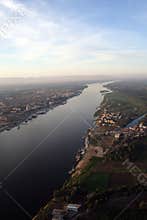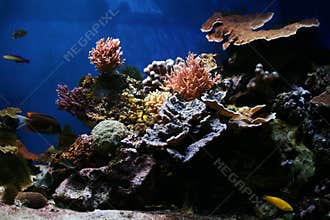The Olgas - Kata Tjuta - Mount Olga [Docker River Road, Uluru-Kata Tjuta National Park, Northern Territory, Australia, Oceania]. Kata Tjuta Also Known As Mount Olga (Or Colloquially As The Olgas), Are A Group Of Large Domed Rock Formations Located 365 Km Southwest Of Alice Springs, In The Southern Part Of The Northern Territory, Central Australia. Uluru, 25 Km To The East And Kata Tjuta Form The Two Major Landmarks Within The Uluru-Kata Tjuta National Park. The 36 Domes, Covering An Area Of 21.68 Kmâ², Are Composed Of Conglomerate, A Sedimentary Rock Consisting Of Cobbles And Boulders Of Varying Rock Types Including Granite And Basalt, Cemented By A Matrix Of Sandstone. The Highest Point, Mount Olga, Is 1066 M Above Sea Level, Or Approximately 546 M Above The Surrounding Plain (203 M Higher Than Uluru). Kata Tjuta Is Located At The Eastern End Of The Docker River Road. The Pitjantjajara Name Kata Tjuta Means 'Many Heads'. The Site Is As Sacred To The Indigenous People As Uluru. The Alternative Name, The Olgas, Comes From The Tallest Peak, Mt Olga. At The Behest Of Baron Ferdinand Von Mueller, Mt Olga Was Named In 1872 By Ernest Giles, In Honour Of Queen Olga Of Wã¼Rttemberg. She And Her Husband King Karl Had Marked Their 25Th Wedding Anniversary The Previous Year By, Amongst Other Things, Naming Mueller A Freiherr (Baron), Making Him Ferdinand Von Mueller; This Was His Way Of Repaying The Compliment. On 15 December 1993, A Dual Naming Policy Was Adopted That Allowed Official Names Consisting Of Both The Traditional Aboriginal Name And English Name. As A Result, Mount Olga Was Renamed Mount Olga/Kata Tjuta. On 6 November 2002, Following A Request From The Regional Tourism Association, The Order Of The Dual Names Were Officially Reversed To Kata Tjuta/Mount Olga. There Are Many Pitjantjatjara Dreamtime Legends Associated With This Place And Nearby Uluru. A Number Of Legends Surround The Great Snake Wanambi Who Is Said To Live On The Summit Of Mount Olga And Only Comes Down During The Dry Season.
ID 81285707610 © Imagineimages | Megapixl.com
CATEGORIES
Sharing is not just caring, it's also about giving credit - add this image to your page and give credit to the talented photographer who captured it.:
KEYWORDS
aboriginal aborigine alice australia basalt boulders docker dome domed dreamtime formation granite great group heads indigenous kata legend legends many mount national northern olga olgas park people pitjantjajara river road rock sacred sandstone site snake springs summit territory tjuta uluru wanambi
























































![Karnak Temple - Pillars - Ancient Egyptian Monument [el-Karnak, Near Luxor, Egypt, Arab States, Africa]](https://images.megapixl.com/mpt/91285756920.jpg?h=220)



![Karnak Temple - Sun Shining Though the Pillar Columns [el-Karnak, Near Luxor, Egypt, Arab States, Africa]](https://images.megapixl.com/mpt/01285259930.jpg?h=220)



![Felucca on the Water - View from Philae Temple [Agilkai Island, Near Aswan, Egypt, Arab States, Africa]](https://images.megapixl.com/mpt/91285750820.jpg?h=220)



